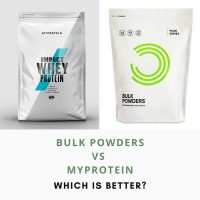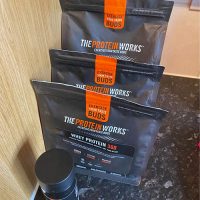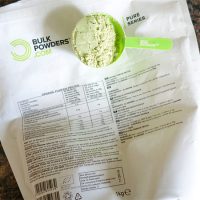Recently updated on November 2nd, 2023 at 08:56 am
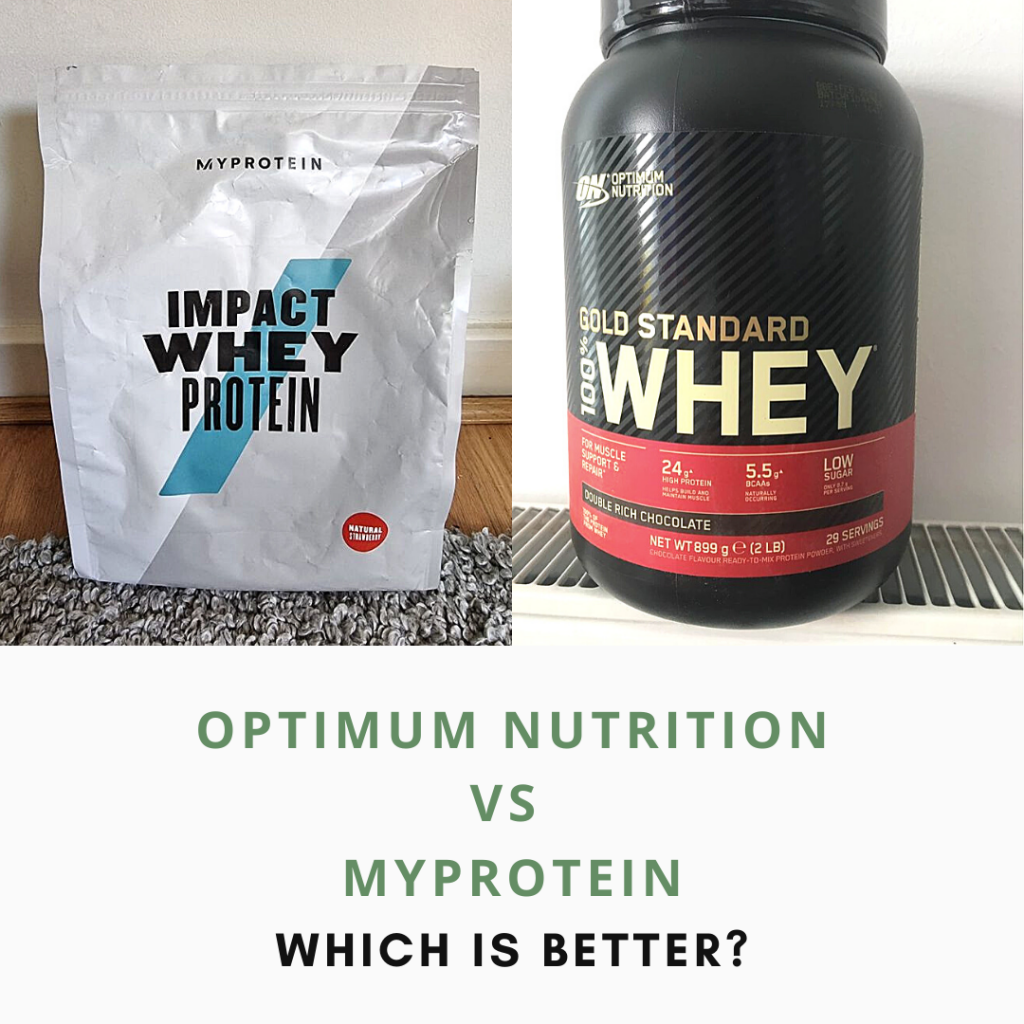
Choosing the right protein powder isn’t fun anymore. With all the flavours, prices, nutritional values, and concerns related, it’s hard to understand what exactly you should be looking for.
Especially since the sports nutrition and supplement industry has stepped up a notch, with brands offering upgraded products that can just come across as overwhelming.
To help you narrow down your choices and focus on your needs, we’ve compared two of the best-rated whey protein brands: Optimum Nutrition and MyProtein based on their nutritional composition, quality, taste and value for money.
Disclaimer: This post contains affiliate links which means I may get a small commission if you purchase a product after clicking on a link. This does not cost you anything.
What you should know about the brands
Did you know that more than 95 thousand tons of whey protein are produced and shipped solely in the UK?
Both Optimum Nutrition and MyProtein have been on top of whey protein production in the UK for quite some time, proving with their consistency and quality that what is promised is in the end delivered.
Optimum Nutrition
Optimum Nutrition has been paving its way to the best-selling brands for 30 + years, mostly focusing on whey protein as their staple product, with now more than 14 flavours to offer.
Optimum Nutrition proudly shows off its success, claiming their products and any changes made to their formula are strictly based on scientific data and up-to-date research on fitness and sports nutritional requirements.
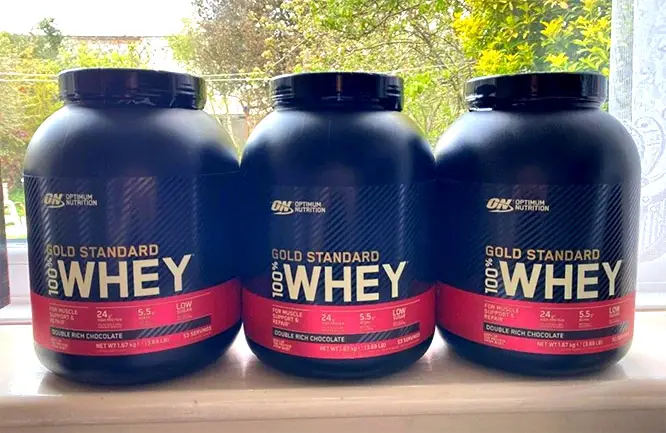
Myprotein
Myprotein hasn’t been around for so long (since 2004), yet with a vast array of sports and nutrition products (including even sports clothing and accessories), it has quickly fought its way to customers’ protein powder bottles for a reason, now with over 40 flavours to choose from.
On their website, MyProtein guarantees top-quality ingredients, certified testing methods, and top-notch production based in the UK, ensuring best-rated sports supplements, amongst which their whey protein powders stand out as the top-selling products.
Optimum Nutrition vs MyProtein – Bestselling protein powders
Both companies explore a variety of whey protein variants but for the purposes of this article the focus will be put on their most popular comparable products: whey concentrate (Impact Whey vs ON Gold Standard) and whey isolate (Impact Whey Isolate vs ON Gold Standard 100% Isolate). But first of all, let’s look at the differences between whey concentrate and isolate and which one you should buy.
Different types of whey protein powders
Based on their fat, lactose and protein content, as well as manufacturing process, whey protein powders mostly found on the racks can be categorized into three main types: whey protein concentrate (70-80% protein), whey protein isolate (80%+ protein), and hydrolysed whey.
Whey concentrate is the most common and widely popular supplementation, essentially a left-over liquid of cheese and other dairy production processes, which is further dehydrated and formed into a powder. Being a natural milk byproduct, whey concentrate is a healthy supplementation option, containing around 80% of protein (depending on the brand), alongside wholesome fats and nutrients, lactose (around 8%), and minerals.
In search of a low-calorie/high-protein option, various technologies have been applied to create a whey isolate, 90-95% protein, low-calorie, low-lactose option. To achieve this, whey isolate powders are also deprived of all the healthy fats and minerals, that basically comprises a wholesome whey supplement.
Finally, whey hydrolysate is also worth mentioning as probably the most advanced form of whey supplementation.
Hydrolyzed whey is produced by breaking down amino acids in whey for better and quicker absorption, making it less prone to causing allergic reactions. That said, given the questionable bitter taste that needs additives, as well as the only slight improvement in whey digestion, it’s questionable how effective this type really is in the sports supplementation world. What’s more, the more complicated the production, the higher the price – another minus for whey hydrolyzation.
Products reviewed in this article are concentrate and isolate options from the two mentioned brands.
Whey concentrate or isolate: Which one should you buy?
The answer to this question depends on what you’re looking for in your whey powder.
Because of its easy and quick production process, whey concentrate is cheaper, easily accessible, and more commonly used in sports supplementation (protein bars, powders, drinks, etc.) than other powders.
It’s also considered healthier and fitting to its supplementation purpose as it recharges the body with necessary fats, amino acids, minerals – essentially everything that makes whey so desirable in sports nutrition. That said, dairy fats add up to calorie content, which is usually a big downside for fitness fans.
On the other hand, if you’re looking for a rapid protein boost whey isolates are a better option. With up to 95% of protein content, this type of powder will bring higher efficacy with no significant calorie boost.
Whey isolates are also great for lactose-intolerant consumers as some brands offer powders with as low as 0.5% lactose content. However, be prepared to invest more in your protein powder if you decide to opt for the isolates.
MyProtein Impact Whey (Concentrate) Protein vs Optimum Nutrition Gold Standard Whey Protein
We’ve scrutinized the most important features of whey concentrate protein powders MyProtein Impact Whey (Concentrate) Protein and Optimum Nutrition Gold Standard Whey Protein to give you a better insight into their true effect and quality:
Nutritional information
It seems that both of these best-selling whey concentrates offer the same amount of the baseline ingredients: protein – 82 g (per 100g), as well as the energy substrates, Branch Chain Amino Acids (BCAA): 5.5g (ON Gold Standard Whey) vs 5.4g (MyProtein Impact Whey) per 30g serving. The BCAAs are responsible for muscle recovery and are a prerequisite for the proper absorption of other amino acids.
However, that’s where the similarities end, given that MyProtein Impact whey is richer in calories with 412 kcal vs. 373 kcal in ON Gold Standard for the same amount (100g), unflavoured options.
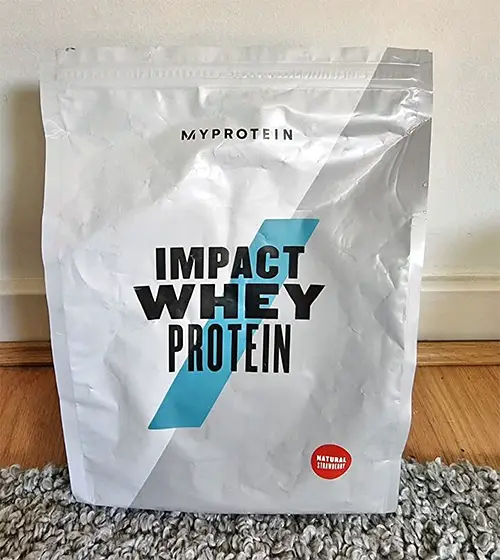
If we dig deeper into the nutritional composition, we can see that this is easily explained by almost double the amount of fat (7.5 g vs 3.7g) and sugars (4.0g vs 2.2g) in MyProtein powder.
Both products are low in salt containing only 0.5 g per 100g of product.
| Nutritional values per 100 g | ON Gold Standard Whey Protein (unflavoured) | Myprotein Impact Whey Protein (unflavoured) |
| Calories | 373 kcal | 412 kcal |
| Protein | 82g | 82g |
| Fat | 3.7g | 7.5g |
| – of which Saturated | 1.2g | 5.0g |
| Carbohydrates | 3.1g | 4.0g |
| – of which Sugars | 2.2g | 4.0g |
| Salt | 0.50g | 0.50g |
| BCAA (Branched Chain Amino Acids) per serving | 5.5g (in 30 g serving) | 4.5g (in 25g serving) |
Flavours and taste/texture
For some consumers, flavour/taste can be the decision-making factor in picking your favourite whey powder. Judged solely by the number of available flavours, MyProtein by far beats not only Optimum Nutrition but also most other brands, with a whopping 55 choices on the market.
That said, a wider range of options doesn’t always mean ‘better’, as there’s only so much you can add to a protein shake to keep it palatable, let alone tasty.
Among the 55 flavours, at least 10 are chocolate variants, some reviewed as delicious, but some as not so much. Some flavours cover the classics (vanilla, strawberry, banana, etc.) while there are also more daring combos (e.g. coffee, raspberry, tiramisu, pineapple, and much more).
Optimum Nutrition sticks to the known (14 flavours) which are more or less attractive to consumers who in general find them appealing, easily digestible and compatible with the milky whey taste (chocolate variants, strawberry, vanilla, banana, etc.)
Sweeteners used
The main sweetener in both products is Sucralose, a common sweetener widely used in protein powders. Apart from the bundle of flavours, MyProtein has widened its offer to healthier sugar-free options, such as the ‘stevia’ range ( banana, blueberry and raspberry, chocolate, chocolate mint, vanilla, strawberry).
Stevia is a calorie-free, fat-free natural sweetener, very high in sweetness, yet a much healthier option compared to artificial sweeteners such as Acesulfame Potassium (K), also found in ON Gold Standard. This artificial additive although safe for consumption has been linked to possible contributions to obesity and diabetes, due to gut microbiome changes it causes.
Optimum Nutrition Gold Standard Whey doesn’t offer a carb-free option, however, there are other sugar-free options (e.g. Optimum Nutrition Lean Whey Sugar-Free) available for those who need to cut down on carbs.
Price and value for money
When it comes to affordability, we’ve compared similar packages (2.5 kg and 2.2 kg) to see their popularity and value for money. Compared to similar products, both MyProtein and Optimum Nutrition products are in the ‘good value for money’ range according to most users, which makes them even more applicable and recommended among fitness enthusiasts, sports nutritionists and satisfied consumers.
Myprotein Impact Whey Isolate vs ON Gold Standard 100% Isolate
When it comes to brands’ whey isolate products, their isolate products (Impact Whey Isolate vs Gold Standard 100% Isolate) are very different. Here are the main differences:
- Myprotein Impact Whey Isolate has more calories per 100g than ON Gold Standard 100% Isolate (373 kcal vs 366 kcal).
- Impact Whey has more protein per 100g (90% vs 83% in ON Gold Standard Isolate).
- Impact Whey has less fat, carbs and salt per 100g. However, it has more sugars in 100g (2.5g) than ON Gold Standard Isolate (1.1g).
- There are only three flavours of ON Gold Standard 100% Isolate with no unflavoured option. Impact Whey, on the other hand, offers over 20 flavours, including the unflavoured option.
- Artificial sweeteners are used in both isolates but some flavours of MyProtein Impact Whey Isolate are sweetened with more natural stevia.
So, ON Gold Standard 100% Isolate vs MyProtein Impact Whey Isolate – which one is the winner?
If you want less calories per 100g, you should pick ON Gold Standard Isolate but then you will get only 83g of protein per 100g.
Overall, Myprotein Impact Whey Isolate still wins as the calorie difference is negligible and the protein content is higher. You will also get more flavour options when choosing Impact Whey and you can even pick stevia-sweetened isolate (Chocolate Mint Stevia Flavour, Blueberry & Raspberry Stevia Flavour) which is something ON Gold Standard Isolate doesn’t offer.
| Nutritional values per 100 g | ON Gold Standard 100% Isolate (Chocolate) | Myprotein Impact Whey Isolate (unflavoured) |
| Calories | 366 kcal | 373 kcal |
| Protein | 83g | 90g |
| Fat | 1.4g | 0.3g |
| – of which Saturated | 0.4g | 0.3g |
| Carbohydrates | 4.5g | 2.5g |
| – of which Sugars | 1.1g | 2.5g |
| Salt | 0.74g | 0.5g |
Myprotein vs Optimum Nutrition: Which one is better?
On a general note, consumers who are looking for a long-lasting whey protein powder that will show consistency and quality should also look for a well-rounded flavourful powder, therefore, before making your final pick, try out several options to make sure you can use the powder for some time, in order to achieve positive results.
Based on all the factors included (nutritional value, taste, price, options, brand), all products have downfalls and pluses.
ON Gold Standard Whey Concentrate is definitely a better option for those who are looking for a product lower in calories and fat. That said, MyProtein Impact Whey Concentrate offers more options both in flavour and healthy sugar-free options, at a slightly more affordable price.
When it comes to whey isolates, Myprotein Impact Whey Isolate is a better option as it contains more protein, less fats, less carbs and less salt. It also has more flavours with some flavours sweetened with more natural stevia.

